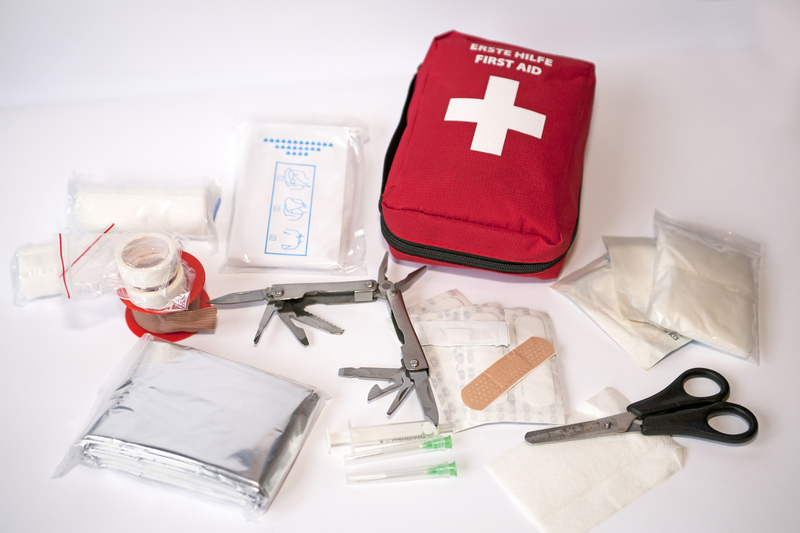Having a complete First Aid kit around in normal times is a pretty basic requirement for just about everyone.
In a survival situation, though, that requirement takes on added urgency because an incomplete First Aid kit can literally lead to death! Here is a list of what you should have at the very minimum.
Oral antibiotics-(or if emergency, fish meds) may also include garlic oil, honey,cayenne,thyme oil,peppermint oil and eucalyptus oil as herbal alternatives or fresh garlic or ginger.
Antibiotic ointment and/or antibacterial herbal salves ( with calendula/tea tree oil/lavender oils)
Multiple sizes of adhesive bandages- (spot, knuckle, size 1×3 or 2 x 4 is great to cover most lacerations
Ace bandages- multiple sizes
Self adhering “Coban” wraps
Kerlix or rolled gauze
Steri strips and butterfly bandages to close minor lacerations
TONS of gauze/dressings (BOTH: sterile and non-sterile 4x4s. Include lots of non-adherent “telfa” pads so healing wounds won’t stick to the dressing)
Xeroform petrolatum dressings (non stick)
ABD pads (usually 5×9), also called combine dressings
12×30 trauma dressings
Maxi Pads and tampons- multi use materials
Tapes- include DUCT, adhesive and paper ( for adhesive tape allergies)
Quality bandage scissor/trauma shears ( ALL METAL, the plastic handle ones break cutting jean material!)
Pliable splinting material (“sam” splints – everything from finger splints to 36 inch rolls that you can cut to size)
Cast material Kit (comes in fiberglass or Plaster of Paris)
Moleskin with padding- for blisters
Scalpels (#10, #11, #15 most popular)
CPR masks
LOTS of nitrile gloves -hypoallergenic (NEVER touch an open wound with bare hands if you can help it)
A few pair of sterile size 7 1/2 or 8 gloves (or more!)
Hand sanitizer/alcohol for cleaning hands and instruments
Antibacterial soap
Betadine swabs/wipes- wipes are great to make a betadine solution with water
60cc or 100cc syringe- for wound irrigation and cleaning
Antiseptics- get lots of various solutions, hibiclens is excellent
Universal Cervical collar
OPAs (Oral Airways) good for preventing occlusion of an airway due to an allergic reaction and while waiting for the epi pen or benadryl to reduce the swelling
BZK wipes-to clean hands/wounds – great for cleaning animal bites(may decrease rabies transmission)
Alcohol pads -to clean instruments/hands
Sting relief Pads
Masks- earloop surgical (for sick people)
N-95s (for healthy people to keep them from getting sick!)
Dermabond (Rx) or super glue ( may burn the skin)
Needle holder (if you are learning how to suture)
Sutures (2-0 nylon- don’t bother with 3-0 or smaller unless working with delicate skin on the face, eyelids, etc. (higher the number=smaller the needle!)
Skin stapler/remover and 2 adson forceps (if you or someone you know knows how to use properly)
Curved and straight Kelly clamps ( to remove foreign objects from wounds)
Tweezers
Several large safety pins
Magnifying glass
Light source -Pen light, head lamp, glow stick, flashlight
Some type of firestarter- to start fires for boiling water or sterilizing instruments, include a container for boiling water in your supplies!
Tongue depressor(s)
Mylar blankets
Wool Blankets
Thermometer
Ammonia inhalants
Cold and Hot Packs (reusable and instant)
Cotton Sheets- can be cut into strips for multiple uses, or used to carry patients
Stretcher- lightweight, portable is best if one is needed
Cot/examining table- a bed is fine with clean sheets
Blood pressure cuff/stethescope- a good quality set would be best
Chux Pads- for use in austere conditions to make a clean surface, also used under a patient to catch fluids, leaking or with incontinence
Clotting powders/dressings (Quikclot, Celox)- cayenne pepper powder may help minor bleeding- use 35,000 HU as a minimum for bleeding.
Styptic pencil- minor bleeding
Tourniquet- such as CAT , only use in severe bleeding that will not stop with direct pressure or clotting agents
Pressure dressings – olaes modular bandage or Emergency Israeli bandage
Blood stopper dressings (dressing with 2 kerlix attached for wrapping)
Q-tips/cotton squares/cotton balls/cotton rolls
Cravat-style triangular bandages
Snake bit kit- must use within seconds of the bite or it is useless
Rubber bag (hot water bottle)
Re-useable GEL packs- can be cooled OR heated
Fels naptha soap- to wash off poison Ivy,oak or sumac from skin and clothes (also a great clothes detergent)
Athlete’s foot powder (lasts longer than creams)
Monistat cream (or equivalent)- for vaginal yeast infections
Eye cup
Eye wash- weak Chamomile tea makes a great eye wash also, may add 1/2 teaspoon raw honey to the tea for pink eye treatments
Eye pads/eye patch
Claritin (non-drowsy antihistamine)- hay fever/allergies
Benadryl
Epi-pen (Rx), if needed for anaphylactic reactions
Sudafed- decongestant,
Pain relievers/analgesics- Advil, Aspirin, Tylenol, etc.
Regardless of your situation, you should always have a comprehensive First Aid kit with you to address the many types of sickness and injury that are serious but do not require a visit to the doctor.
In a survival situation, that need is even more acute; without proper first aid, the sick get sicker and the injured run risks of adding sickness like an infection to their already serious condition.
To learn more about First Aid supplies you should keep in stock, check out Doom and Bloom.

I don’t see a TQ.